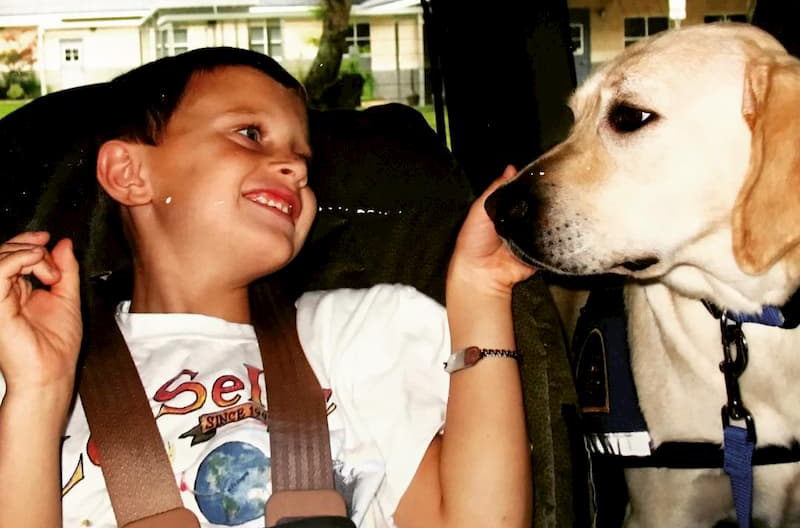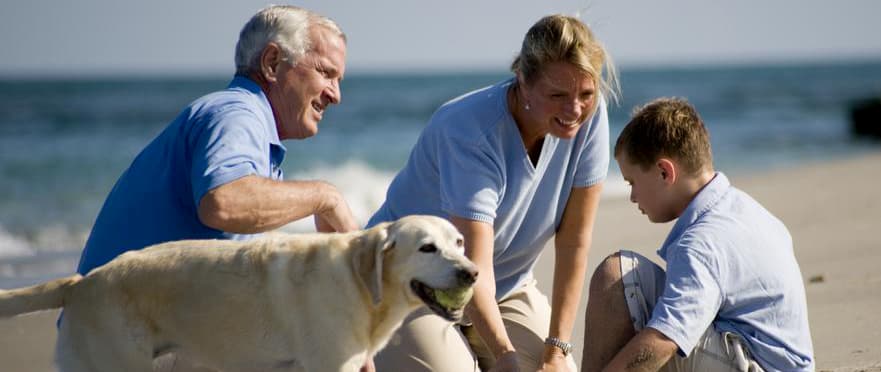
Our Autism Journey with a Canine Companion
By Pamela Minelli
Autism and Support Animals
I was never a dog person. I grew up in a family of six with two working parents, so life was too chaotic for a pet. Or at least that’s what my Dad told me when I came home one day with a little kitten from the neighbor’s litter down the street. My husband grew up with at least 2 dogs in his house during his childhood, so we always thought we’d get one once we settled in one place.
When Andrew was born, we knew early on that something wasn’t quite right. He couldn’t sit up at 6 months, and the pediatrician sent us for testing after his 9-month appointment. He started physical therapy at 11 months, followed shortly by occupational therapy, and then speech. But everyone who saw him told us that he didn’t have autism, because he had “great eye contact”.
Fast forward a couple of years, we received Andrew’s autism diagnosis, and he started attending a pre-school for children with ASD. We threw ourselves into all kinds of therapies – some proven and others not – including ABA, Tomatis listening, equine therapy, chelation, you name it. Adding a pet to our family wasn’t even a consideration in those early years, at least in my mind.
Finding a “canine companion”
When Andrew was around 8 years old, we heard about an organization in Orlando called Canine Companions for Independence. They had recently started placing dogs with families affected by autism, so I saw it as another kind of therapy for Andrew and a way to make my husband happy! I really didn’t see any benefit to me and wasn’t looking forward to the 2 weeks we had to spend in Orlando to get trained as “facilitators” for our dog.
The first day, the instructors at Canine Companions tell you that your family will be matched with a dog, so not to get attached to one, because you may not get that particular dog. Of course, I didn’t listen and wanted Allie right away – she was the smallest and a yellow lab, and I was thinking about shedding on my light tile floors. We did end up getting paired with Allie, and the training flew by – before we knew it, we were on our way home with Allie and a big dog crate.

At first, Andrew didn’t pay much attention to Allie – she didn’t bother him in any way, which was my first concern, but he didn’t seem to notice that she was around. Allie, however, loved being around Andrew and followed him everywhere. One day, we encouraged Allie to jump on the bed with Andrew, and everything changed. Andrew treated Allie like a sensory blanket and snuggled up against her. He also realized that he could get sensory input from petting her, and his hand clapping behavior started to decrease.
 The most amazing change was the way the community interacted with us when we were with Allie. When we traveled and Andrew had a behavior, people looked uncomfortable and usually avoided engaging with our family. However, when Allie was with us in the airport, people would approach us and ask all about her… and Andrew. They knew from Allie’s vest that she was a working dog, and they wanted to help us – such a difference! It helped me relax during stressful travel days, and vacations became much more enjoyable.
The most amazing change was the way the community interacted with us when we were with Allie. When we traveled and Andrew had a behavior, people looked uncomfortable and usually avoided engaging with our family. However, when Allie was with us in the airport, people would approach us and ask all about her… and Andrew. They knew from Allie’s vest that she was a working dog, and they wanted to help us – such a difference! It helped me relax during stressful travel days, and vacations became much more enjoyable.
Andrew and Allie’s life together
Allie and Andrew grew up together – buddies on the beach, in the pool and around our neighborhood. When Allie started approaching “retirement age”, we got back in touch with Canine Companions. We applied for a dog that didn’t meet the requirements to graduate from their training program. We didn’t know how much longer Allie would be part of our family, so Sophie became our 2nd dog! With young Sophie around, Allie perked up quite a bit and we were happy to have 3 more wonderful years with her. And Andrew had two dogs to pet and snuggle with!
This weekend we’ll go to the beach with Allie’s ashes and remember the profound impact she had on our family, mostly on me. Allie turned me into a dog person – a happier, more relaxed person who could then be a better mom and wife. Autism can be devastating to a family – everyone knows about the divorce rate and emotional and financial challenges. But sometimes, the autism journey changes us in ways that we never expect and are hard to describe to a “neurotypical family”.

Photo by Sandy McPherson
.

Pamela Minelli is a member of the Board of Directors for Els for Autism Foundation and has over 35 years of experience in sales, marketing and fundraising. She is a community leader in Southeast Florida serving individuals with autism spectrum disorders (ASD) and has been recognized by several organizations for her leadership and volunteer activities. She is also the parent of a 21-year-old man with ASD.




